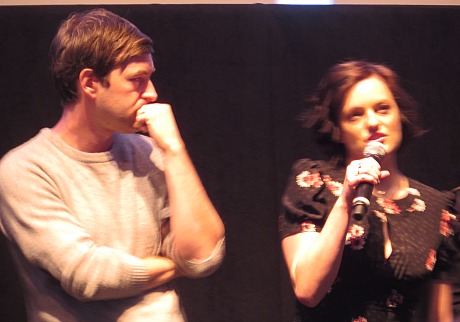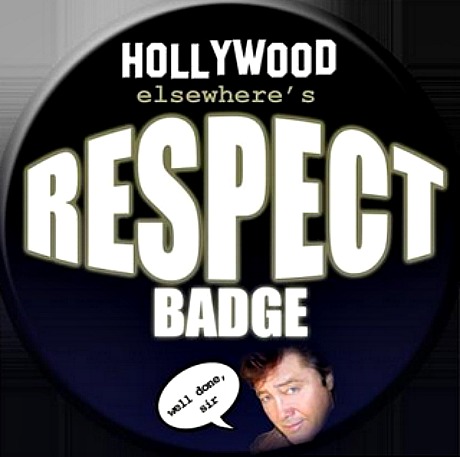Allegedly “less procedural and more darkly comedic than other cop shows, Danny Boyle‘s Babylon (debuting in England on 2.9) is about (a) the “increasingly poor public image of a London police force led by a tight-lipped chief” (Jimmy Nesbitt), (b) an attempt at a p.r. makeover via the department’s new media liaison (Brit Marling), and (c) “a national firestorm triggered by the terrifying reports of a sniper on the loose.” Why isn’t this being shown at Sundance?
Daily
Dispute
A 10.22 piece by The Wrap‘s Sharon Waxman declares that Sundance ’14 hasn’t delivered any “breakout buzzy” films. Not by my yardstick. I’ve seen five that easily qualify — Whiplash, The Skeleton Twins, Laggies, Boyhood and Life Itself. Plus I found The Battered Bastards of Baseball delightful (as well as obvious material for a feature if anyone wants to give it a shot). And you could add The One I Love for at the very least delivering a metaphorical observation about how relationships tend to evolve, etc.
Waxman claims that “while the festival had glimmers of excitement, the movies were — in the aggregate — interesting but not inspiring, thought-provoking but not thrilling” — nope.
On top of which Marshall Fine wrote this morning that the 3D The Girl from Nagasaki is “bold, experimental, engagingly weird…the most adventurously artistic vision I’ve seen in years. It’s destined to be a movie for critics, rather than audiences, I’m afraid, because the public appetite for more oblique entertainment simply doesn’t exist on the scale necessary for a 3D release in theaters.”
Ryan Is Toast
I missed seeing Jack Ryan: Shadow Recruit before Sundance (Paramount didn’t want to show it to me, I didn’t pester them about it) and now it’s dead. The word all along has been “not bad, not terrible but not good enough.” I probably won’t even see it in a theatre. At best I might rent the high-def version on Vudu but I can’t promise anything. 10.13 HE post: “Chris Pine as Robo-Ryan — Jacksnapper injected with video-game DNA. Seemingly related to Captain Kirk. Kenneth Branagh provides the robo-direction. David Koepp wrote the robo-screenplay. My, how sensibilities have changed since Clear and Present Danger came out in ’94 (i.e., the Pleistocene era).”
All Or Nothing
As I intend to see the longer, more explicit 2 and 1/2 hour version of Lars Von Trier‘s Nymphomaniac, Part 1 at next month’s Berlin Film Festival, I have no regrets about missing last night’s Sundance sneak of Nymphomaniac Part 1, which ran something like two hours plus. “So to recap, Stacy Martin has lots of sex while Charlotte Gainsbourg tells a story and Stellan Skarsgard lectures us about science, which in one sense would be short-shrifting the film and in another describes pretty much all you need to know,” reports L.A. Times guy Steven Zeitchik. “There are no shortage of story lines outside the movie. Is the graphic aspect a help or a hindrance at the box office? Will Von Trier’s infamous Cannes appearance a few years ago in, which he thought it funny to call himself a Nazi, work against him? And will the star attachments break the film out of the art house or just fill up some entertainment news magazine air-time with breathlessness about stars baring it all?”
Metaphorical Couples Therapy
Charlie McDowell‘s The One I Love, the Mark Duplass-Elizabeth Moss two-hander which screened last night at Park City’s MARC theatre, delivers a highly unexpected, Twilight Zone-ish twist about 20 minutes in. (I know — the words “highly unexpected” are uncool in themselves but what am I supposed to say?) I didn’t know zip before I saw it last night, and I loved grappling with a fresh and lively idea. I hate spoiling but how the fuck do I get around it? Others clearly aren’t trying very hard. The headline of a recently-posted L.A. Times interview piece with Moss (authored by Mark Olsen) is about as unsubtle as it gets. (It ostensibly refers to Moss having two films at Sundance but don’t try that shit with me — I know what they’re doing.)

Old Material
This morning Screencrush‘s Mike Sampson posted a “rare” eight-minute clip of Quentin Tarantino and Steve Buscemi rehearsing Reservoir Dogs material in 1991. It’s not “raw” but cut together like a film. News flash: Video footage from the same rehearsal session was posted in August 2011. Tarantino was about 35 or 40 pounds lighter back then.
Raid 2 Revulsion = Fan Delight
A Hollywood Elsewhere respect badge is hereby offered to Screencrush‘s Jordan Hoffman for manning up and walking out of last night’s 9:45 pm screening of The Raid 2 — a film that I wouldn’t have seen with a gun in my ribs. I saw the original Raid (thanks again to James Rocchi for urging me to do so) and learned my lesson. From Hoffman’s review: “Ten minutes before the end I turned to a colleague and said ‘all right, enough of this’ and walked out — the first time I’ve ever left a film that I intended to review in my career. I’ve stuck through far worse films. You might even interpret my reaction as a mark of success for director Gareth Evans and his team of choreographers and makeup artists. The violence in this unrated cut is so relentless, so absolutely brutal, that I just couldn’t take anymore. While athletically and technically impressive, the final fights in The Raid 2 are so unpleasant that I realized that if I didn’t race out of my seat, I may have vomited in the theater.” Correction: the term is “ralph,” not vomit. Never use a blunt, common-sounding term to describe a vulgar or distasteful act.

Blocking Mechanism
Jim Mickle‘s Cold in July didn’t cut it either. I bailed about halfway through. The part I saw felt like a Jim Thompson melodrama mixed with the kind of low-rent VOD film that throws in a totally unexpected third-act-plot-twist because viewers won’t expect it. I’d read the reviews, I knew what was coming…later. But the main issue (and I’m not saying this just to sound eccentric or obstinate) is Mickle’s decision to have his lead actor, Michael C. Hall, wear a mullet. My heart sank when I saw it. A brick wall. I tried to get past it but I couldn’t. I should have just walked out when I saw the damn thing but I stupidly hung in there.
Cold in July is set in rural Texas in 1989, and I realize that low-rent guys who lived in backwaters were still wearing mullets back then but I don’t care — I really can’t roll with a lead character who wears one. And Mickle knows there are thousands (perhaps tens or hundreds of thousands) who feel the same way. He’s not stupid– he knows that mullets are just as much of a blocking mechanism as having a lead character with (excuse the vulgar imagery) phlegm running out of his nose. Something like this stops the movie in its tracks. Imagine if Humphrey Bogart had a gross runny nose all through The Maltese Falcon — do you think that might have affected its popularity to some degree? Same thing with Hall’s mullet, and Mickle knows this. I have no patience with directors who pull this shit, and so I quit. I’m sorry but stuff like this kills me.
Couldn’t Stand Hellion
I bailed on Kat Chandler‘s Hellion, which everyone seems to admire, at roughly the one-hour mark. This is the kind of earnestly grungy indie that critics like Guy Lodge fall for or write about with some admiration, and which I want to escape from as soon as possible. I hate dealing with the problems of pissed-off, under-educated, lower-middle-class types. They’re not my kind of people. I didn’t give a damn about the anger or the pain or the bleachy color or the buzzing dirt bikes. I didn’t care about the characters or their problems or the cops or the social services lady…include me out.
The hell-bent Jacob, played by young Josh Wiggins…sorry, man. The angry, alcoholic, widowed dad played by HE nemesis Aaron Paul (who grew a beard and gained weight for the role — his head is shaped like a basketball)…later. Juliette Lewis is agreeably humane as the sister of Paul’s absent wife, but otherwise I wanted to put this hellish environment behind me as quickly as possible. It gave me a damn headache.
Wine, Pasta, Winding Roads, Byron & Alanis Morissette
One good Trip deserves another, and so Steve Coogan, Rob Brydon and director Michael Winterbottom have delivered an affable, eye-filling, generally amusing film about a restaurant tour of Italy. Their route follows the Italian journeys of Lord Byron and Percy Byshe Shelley in the early 1800s, so that means Piemonte, Liguria (including a possible visit to Cinque Terre, or at least an area that resembles it), Rome, Pompeii, Napoli and the Amalfi Coast. They ride around in a Mini-Cooper, taking in the scenic splendor of the hilly regions and gorging on plates and plates of pasta, vegetables, truffles, seafood and various heavily sauced entrees. Italy has never been about dieting. Or abstaining from drink. Coogan is sober when he starts but soon succumbs to the lure of the grape.

Steve Coogan, Rob Brydon in Michael Winterbottom’s The Trip.
The Verdict
The moderately positive to middling reviews of Anton Corbijn‘s A Most Wanted Man convinced me that I didn’t absolutely, positively need to see it here in Park City. Down the road, yes, but not now. Unless…you know, it’s easy and there’s nothing better showing at the moment. I’m sorry but once the word gets around that your film has issues, you’re more or less finished. Up here, I mean. Among the red pass know-it-alls.
I Can Take It
I’m hesitant. I’m not sure how this is going to work out. But I’ve got five films on today’s Sundance Film Festival schedule, and the first one starts in 40 minutes. Michael Winterbottom‘s The Trip to Italy at 9 am. Kat Chandler‘s Hellion (which I’m not looking forward to because it stars Aaron “tennis ball in a gray tuxedo” Paul) at 12:30 pm. Jim Mickle‘s Cold in July at 3:30 pm. Pawel Pawlikowski‘s Ida (which I should have seen at Telluride last September) at 5:45 pm. And Charlie McDowell‘s The One I Love at 8:30 pm.
